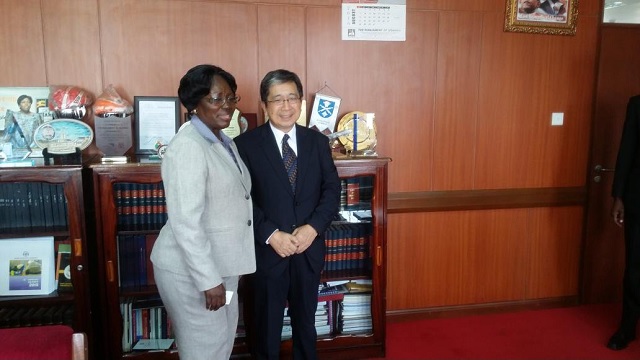
Kampala, Uganda | THE INDEPENDENT | The Japanese Government has committed about 2.1 billion Uganda shillings for the promotion of disaster risk reduction and management in Kasese District.
The funding is an addition to the 1.6 Billion shillings that Japan had already donated to Kasese through Save the Children to minimize damages caused by disasters in the district.
Kasese is a disaster-prone area, the district has suffered flooding, landslides, drought and storm winds among other natural disasters.
The Japanese ambassador to Uganda Kazuaki Kameda made the announcement during the commissioning of phase one of the Disaster Risk Reduction (DDR) project and launch of DDR phase two at Katholhu Primary School in Katholhu Village, Nyakiyumbu sub-county Kasese district.
In 2018, the 1.6 Billion shillings that had earlier been donated to the district through Save the Children, was used to establish and operationalize the disaster management committees at the various levels of government ranging from the village to the district.
The money was also used to build the capacity of the village disaster management committees in mobilizing the communities to be quick in responding to any emerging disasters within the communities.
Trenches for passage of excess water whenever it floods have been constructed in different areas of the district.
A number of items including wheelbarrows, tents, and voice amplifiers to alert the community about any disasters and hoes were purchased to assist the community reduce their vulnerability whenever any natural disasters occurs.
Phase two of the project is expected to strengthen and comb the areas that were being implemented under phase one.
Kameda said it is important to appreciate the fact that whereas it is near to impossible to stop natural disasters from occurring, empowering local communities to quickly respond to the disasters can go a long way in mitigating the extent of the damage caused by any disasters when they occur.
He, however, urged all people to be directly involved in DRR project activities if it is to be a success.
He also called the implementers of the program to ensure transparency and proper use of the funds towards disaster preparedness and risk reduction.
Musa Ecweru, the Minister of State for Disaster Preparedness said the support from the Japanese government is very timely and appealed for more such interventions.
He added that government is considering using the Kasese Village Disaster Committees as a model to train the rest of the country on disaster preparedness and risk reduction.
Brechtje Van Lith, the country director Save the Children, appealed to government to add funding for DRR activities in the country’s disaster management policy.
Lith emphasized the need for district disaster management committees to guide planning at the district level to ensure readiness in mitigating effects of natural calamities.
Kasese District Chairperson Geoffrey Sibendire Bigogo appreciated the efforts of the Japanese government and central government for their efforts in supporting the people of Kasese.
Bigogo urged the people to own the DRR project so that with or without funding, the people can continue with the readiness to reduce disaster damages.
********
URN
 The Independent Uganda: You get the Truth we Pay the Price
The Independent Uganda: You get the Truth we Pay the Price



